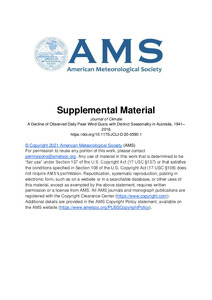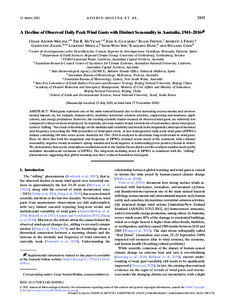Por favor, use este identificador para citar o enlazar este ítem:
http://hdl.handle.net/20.500.11765/12966
A decline of observed daily peak wind gusts with distinct seasonality in Australia, 1941–2016
Registro completo de metadatos
| Campo DC | Valor | Lengua/Idioma |
|---|---|---|
| dc.contributor.author | Azorín Molina, César | es_ES |
| dc.contributor.author | McVicar, Tim R. | es_ES |
| dc.contributor.author | Guijarro Pastor, José Antonio | es_ES |
| dc.contributor.author | Trewin, Blair C. | es_ES |
| dc.contributor.author | Frost, Andrew J. | es_ES |
| dc.contributor.author | Zhang, Gangfeng | es_ES |
| dc.contributor.author | Minola, Lorenzo | es_ES |
| dc.contributor.author | Son, Seok-Woo | es_ES |
| dc.contributor.author | Deng, Kaiqiang | es_ES |
| dc.contributor.author | Chen, Deliang | es_ES |
| dc.date.accessioned | 2021-06-10T07:04:57Z | - |
| dc.date.available | 2021-06-10T07:04:57Z | - |
| dc.date.issued | 2021 | - |
| dc.identifier.citation | Journal of Climate. 2021, 34(8), p. 3103–3127 | es_ES |
| dc.identifier.issn | 0894-8755 | - |
| dc.identifier.issn | 1520-0442 | - |
| dc.identifier.uri | http://hdl.handle.net/20.500.11765/12966 | - |
| dc.description.abstract | Wind gusts represent one of the main natural hazards due to their increasing socioeconomic and environmental impacts on, for example, human safety, maritime–terrestrial–aviation activities, engineering and insurance applications, and energy production. However, the existing scientific studies focused on observed wind gusts are relatively few compared to those on mean wind speed. In Australia, previous studies found a slowdown of near-surface mean wind speed, termed ‘‘stilling,’’ but a lack of knowledge on the multidecadal variability and trends in the magnitude (wind speed maxima) and frequency (exceeding the 90th percentile) of wind gusts exists. A new homogenized daily peak wind gusts (DPWG) dataset containing 548 time series across Australia for 1941–2016 is analyzed to determine long-term trends in wind gusts. Here we show that both the magnitude and frequency of DPWG declined across much of the continent, with a distinct seasonality: negative trends in summer–spring–autumn and weak negative or nontrending (even positive) trends in winter. We demonstrate that ocean–atmosphere oscillations such as the Indian Ocean dipole and the southern annular mode partly modulate decadal-scale variations of DPWG. The long-term declining trend of DPWG is consistent with the ‘‘stilling’’ phenomenon, suggesting that global warming may have reduced Australian wind gusts. | es_ES |
| dc.language.iso | eng | es_ES |
| dc.publisher | American Meteorological Society | es_ES |
| dc.subject | Wind gusts | es_ES |
| dc.subject | Natural hazards | es_ES |
| dc.subject | Wind speed | es_ES |
| dc.title | A decline of observed daily peak wind gusts with distinct seasonality in Australia, 1941–2016 | es_ES |
| dc.type | info:eu-repo/semantics/article | es_ES |
| dc.relation.publisherversion | https://doi.org/10.1175/JCLI-D-20-0590.1 | es_ES |
| dc.rights.accessRights | info:eu-repo/semantics/openAccess | es_ES |
| Colecciones: | Artículos científicos 2019-2022 | |
Ficheros en este ítem:
| Fichero | Descripción | Tamaño | Formato | ||
|---|---|---|---|---|---|
| 10.1175_JCLI-D-20-059... | 3,89 MB | Adobe PDF |  Visualizar/Abrir | ||
| A_Decline_Observed.pdf | 6,8 MB | Adobe PDF |  Visualizar/Abrir |
Los ítems de Arcimis están protegidos por una Licencia Creative Commons, salvo que se indique lo contrario.





